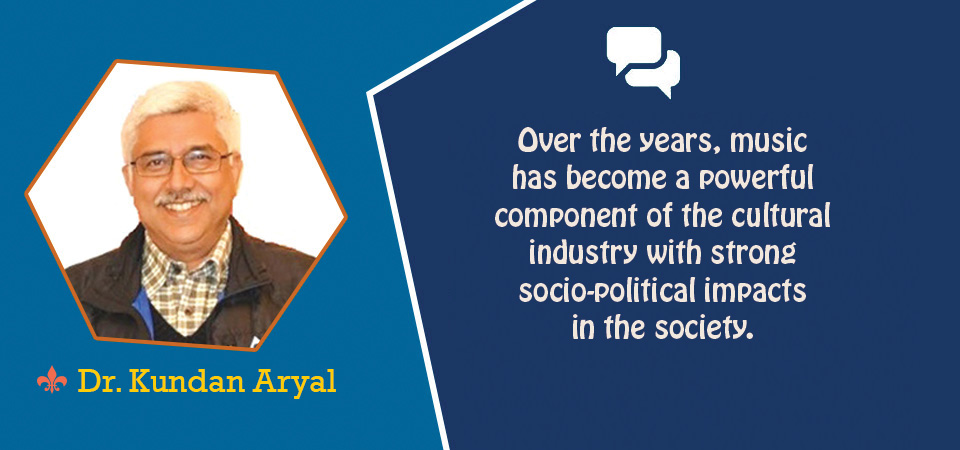Music As Means Of Communication

Dr. Kundan Aryal
Denis McQuail, a prominent media scholar, argues that relatively little attention has been given to the music as a mass medium in theory and research. Mentioning that the recording and replaying of music began around 1880 and were quite rapidly diffused, based on the wide appeal of popular songs and melodies, he states that much radio content since the early days has considered music, even more so since the rise of television. He presents a high degree of internationalisation and diversity of reception possibilities among the salient features of recorded music or phonogram media.
When president Bidya Devi Bhandari paid tribute to iconic Indian singer Lata Mangeshkar last week, it demonstrated that the recorded music or phonogram media accompanied the features such as a high degree of internationalisation and diversity of reception. The President also recalled her because she has given voice to Nepali songs. Prime Minister Sher Bahadur Deuba also remembered the legendary singer who gave her voice to some Nepali songs as well.
Evolving echnology
There are numerous observations over the changes in the broad character of the phonogram since its beginning. According to McQuail, the first change was the addition of radio broadcast music to phonogram records, which greatly increased the range and amount of music available and extended it to many more people who had access to gramophones. Then, the transitions of radio from a family to an individual medium in the post-world-war transistor revolution was a second major change, which opened up a relatively new market of young people for what became a burgeoning record industry.
Over time, portable tape players, the Walkman, compact disc and music video and now the internet-based media, including YouTube, have become the effective medium of music. The world has witnessed multiple technologies of recording and dissemination over the years. However, all of them have the same soul that is music. No one can imagine popular broadcasting without music. The mass media in the form of broadcasting is based on musical strength. The success of reality music shows around the world is based on the emotional link with the public. The trend also tells about the language of emotion, a universal flow of non-verbal communication as well.
In music, people mostly don't care about the words if there is melody. Hence, over the years, music has become a powerful component of the cultural industry with strong socio-political impacts in the society. Since it has been mediating society and human behaviour, it is a form of mass medium. Over one and a half-century recorded and replayed music has underwent a convenient label with its numerous media manifestation, right from radio to television and recently to internet-based media.
Recorded media includes film, music and sound recording. Hence, phonogram is equally an embedded part of the mass medium such as film and broadcasting, both radio and television. It is because of that pervasiveness of recorded music, the entire South Asia mourns the demise of Lata Mangeshkar. Nepali people also expressed their heartfelt condolences by recalling a few Nepali songs crooned by her. Because of her melodious voice and active longevity, she has been considered one of India's greatest cultural icons. Moreover, the political leaders, public intellectuals and the common people from the South Asia region paid tributes to her. Pakistani Prime Minister Imran Khan stated that the subcontinent has lost one of the truly great singers the world has known. Leaders as well as people from Bangladesh and Sri Lanka also paid tribute to her.
Though the significance of music has been given little attention, the historical chronologies show that its relationship to social events has been recognised and occasionally celebrated in the area of cultural studies. On the contrary, the ruling elites, who want to maintain status quo, are often afraid of its relationship to social events as this can disrupt the existing power structure. During the Panchayat regime, musical bands such as Ralfa and Sankalp were involved in the campaign to restore democracy much to the chagrin of autocratic regime. Their songs and music had fired the imagination of young people, inspiring them to engage in anti-Panchayat movement.
Musical message
Since the content of music has never been easy to regulate, the Maoists successfully communicated their message across a wide range of population, especially in the rural areas, through music during the 10 years long violent campaign. Their cultural troupes acted as an effective instrument to mobilise masses in their favour.
Non-recorded or recorded music is part of human. As Lata Mangeshkar touched the hearts of billions of people through her tuneful songs, the political parties of all shades came to pay tribute to her. This clearly shows that music pushed all forms of political boundaries and becomes a universal language. She has sung in more than a dozen languages. It is not the language that made her so popular but it is her sonorous voice that earned her the title of ‘Queen of Melody’ in the region and beyond.
(Dr. Aryal is associated with the Central Department of Journalism and Mass Communication of Tribhuvan University.)
Recent News

Do not make expressions casting dout on election: EC
14 Apr, 2022
CM Bhatta says may New Year 2079 BS inspire positive thinking
14 Apr, 2022
Three new cases, 44 recoveries in 24 hours
14 Apr, 2022
689 climbers of 84 teams so far acquire permits for climbing various peaks this spring season
14 Apr, 2022
How the rising cost of living crisis is impacting Nepal
14 Apr, 2022
US military confirms an interstellar meteor collided with Earth
14 Apr, 2022
Valneva Covid vaccine approved for use in UK
14 Apr, 2022
Chair Prachanda highlights need of unity among Maoist, Communist forces
14 Apr, 2022
Ranbir Kapoor and Alia Bhatt: Bollywood toasts star couple on wedding
14 Apr, 2022
President Bhandari confers decorations (Photo Feature)
14 Apr, 2022











